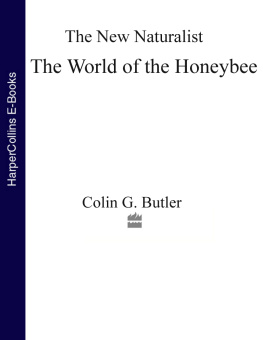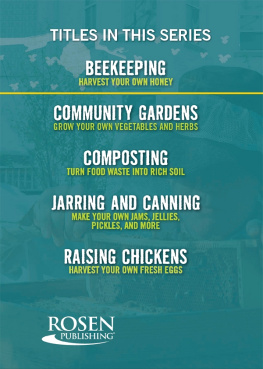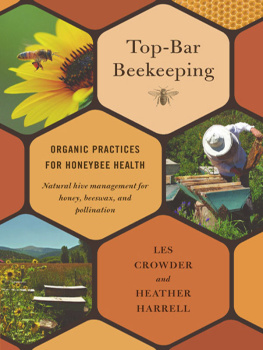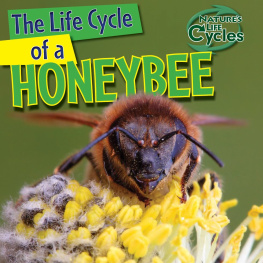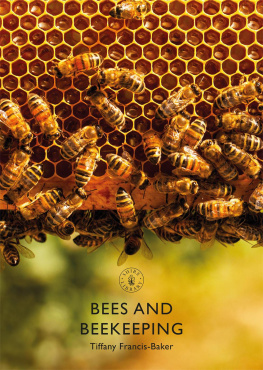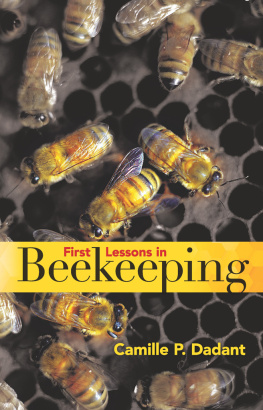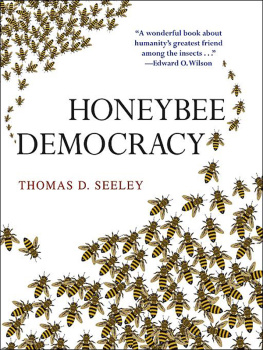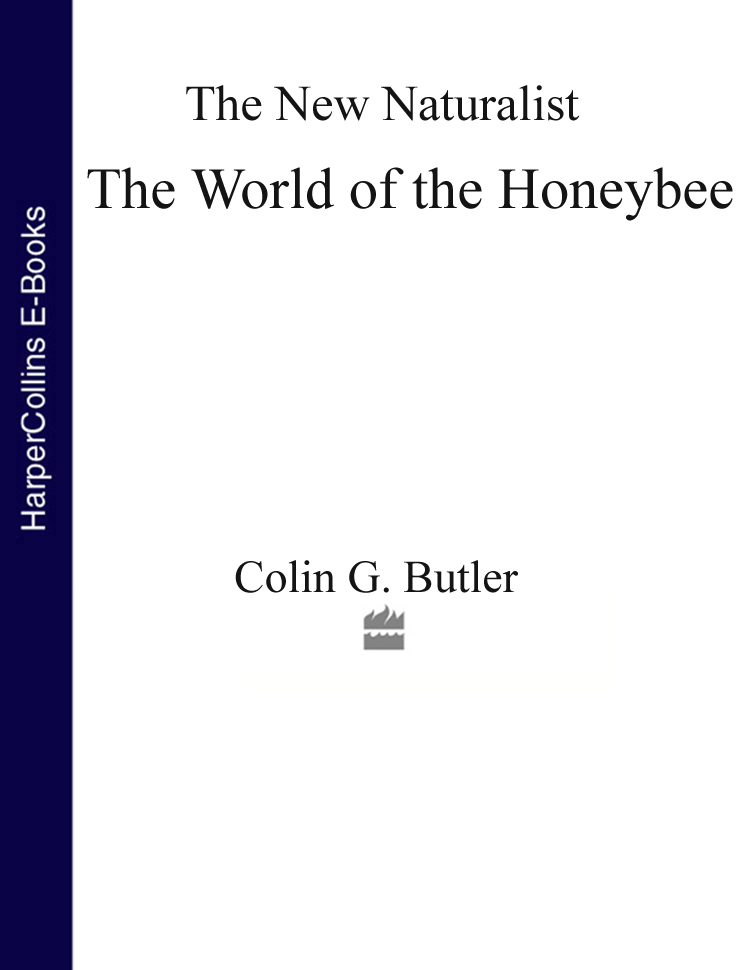EDITORS:
MARGARET DAVIES C.B.E. M.A. Ph.D.
JOHN GILMOUR M.A. V.M.H.
KENNETH MELLANBY C.B.E. Sc.D.
PHOTOGRAPHIC EDITOR:
ERIC HOSKING F.R.P.S.
The aim of this series is to interest the general reader in the wild life of Britain by recapturing the inquiring spirit of the old naturalists. The Editors believe that the natural pride of the British public in the native fauna and flora, to which must be added concern for their conservation, is best fostered by maintaining a high standard of accuracy combined with clarity of exposition in presenting the results of modern scientific research.
Inter omnia tnsecta principatus apibus, et
jure praeapua admiratio.
PLINY. Lib. II. c.5
CONTENTS
LIST OF PLATES
IN COLOUR
IN BLACK AND WHITE
IT IS almost exactly twenty years since the first edition of The World of the Honeybee was publishedtwenty years during which many exciting advances in our knowledge of the behaviour and physiology of the honeybee have been made. These include much more information about the chemical compounds (pheromones) produced by larvae as well as adult queens and workers and of their role in controlling the behaviour of the individuals of which a honeybee colony is composed, and thus of the colony as a whole. The sex attractant released by the queen which enables flying drones to find her has been discovered and found to be the same substance as the principal component of the queen substance which I postulated in 1954. Queen substance in its turn is now known to be a mixture of several substances most, but perhaps not all, of which are found in the secretion of the queens mandibular glands; substances that not only inhibit unnecessary queen rearing by the worker bees and development of their ovaries, but also help the workers of swarms to find their queens and cluster quietly with them.
The truth of the old idea that the worker bees of a colony are able to distinguish their own queen from similar queens belonging to other colonies has at last been demonstrated experimentally, as has the much greater part played in swarming and foraging, as well as home-finding, by the scent produced in the Nassanoff glands of worker bees than had hitherto been supposed. The composition of the Nassanoff scent, one of the first pheromones to be discovered, has also been elucidated.
The question as to how a queen honeybee distinguishes between worker and drone cells in the darkness of the hive and so is enabled to lay fertilised and unfertilised eggs in them, respectively, has also been discovered.
We now know more about the ways in which worker bees communicate with each other and how they recognise their own hives and colony members; and the part that substances that bees deposit inadvertently when running around their hive entrancesfootprint substancesplay in helping homecoming foragers to find the entrances of their hives has been recognised.
More has been learned about direction finding and foraging, as well as about caste determination. Indeed, it seems as though we must at last be on the verge of discovering the secret of the way in which the queen and worker castes are determined.
Although few of the new discoveries that have been made by research workers in many different countries appear to have any immediate, direct application to problems of practical beekeeping, they are important because they enable beekeepers to recognise and discard many practices that have been based on ignorance and fallacy, and to adopt a much more rational approach to beekeeping than has hitherto been possible.
I am very grateful to the Editors of the New Naturalist series and to my Publishers for allowing me to make so many changes in the text and, indeed, to rewrite many parts of it, in order to bring it more nearly up-to-date, although even small changes in the text are very expensive to make and must necessarily increase the price at which a book can be sold. Because of the expense that would have been involved I have not made several minor alterations which, although I think them desirable, are not essential. I have not, for example, altered the specific name of the Eastern honeybee from Apis indica to Apis cerana in order to conform with the rules of taxonomic nomenclature, nor have I changed queen substance to queen substances.
Finally, I hope that I may be allowed to echo the words of Gilbert White who wrote: These observations are, I trust, true in the whole, though I do not pretend to show that they are perfectly void of mistake, or that a more nice observer might not make additions, since subjects of this kind are inexhaustable.
T HE HONEYBEE is a social insect, that is to say an insect which lives in a society. It is, therefore, desirable that we should be quite clear what we mean by an insect society, before we begin to consider how such a complicated organisation as a honeybee society came into being. Unfortunately it is very difficult to frame a comprehensive and exact definition of social life. Indeed, at a meeting of the British Association some time ago at which the behaviour of social insects was discussed, nobody was able to put forward a definition which was acceptable to everyone present and which was considered to be entirely adequate.
Some people may say, Well, why worry so much about trying to define exactly what you mean by social life; we know that the honeybee is a social insect, that the ants are social insects, and that at least some of the wasps also lead social lives: and surely provided that one knows these things there is no need to worry about a definition? Now, for many purposes we can get along quite well without any definition, knowing that a honeybee is called a social insect without understanding why this is so. However, in order that we may be able to distinguish those insects which live social lives from those which do not, it is desirable that we should have a definition. Probably the most accurate and comprehensive definitions of insect social life are those that have been put forward by Dr. W. Morton Wheeler and which have been strongly supported by Dr. A. D. Imms. One of these definitions states that a social insect is an insect which lives in a society; each society consisting of the two parents (or at least the fecundated female) and their offspring; the two generations living together in a common abode or shelter and exhibiting at least some degree of mutual co-operation. If we accept this definition, as I think we must, it follows that amongst the social insects there is necessarily a lengthening of the lives of the adults, at any rate of the colony mother, since she at least lives sufficiently long to associate with her offspring; whereas, in the great majority of insects the mother dies without having had the least contact with her offspring, indeed in many cases before they have even hatched from their eggs. Such lengthening of the life of the colony mother has undoubtedly been associated with a degree of specialisation for a particular type of work at the expense of other types. The degree to which such specialisation has taken place varies very greatly, however, amongst the different groups of social insectsin some cases even within a single group. In the case of the queen honeybee specialisation for egg production has gone a very long way. This has not been brought about by acquisition of the ability to undertake a new type of work, but rather by the gradual suppression of any tendency to perform the other types of work that were previously carried out by her more primitive ancestors. The primitive ancestors of the queen honeybee undoubtedly undertook such duties as nest-building, foraging for food and care of the young; duties which she no longer performs.

